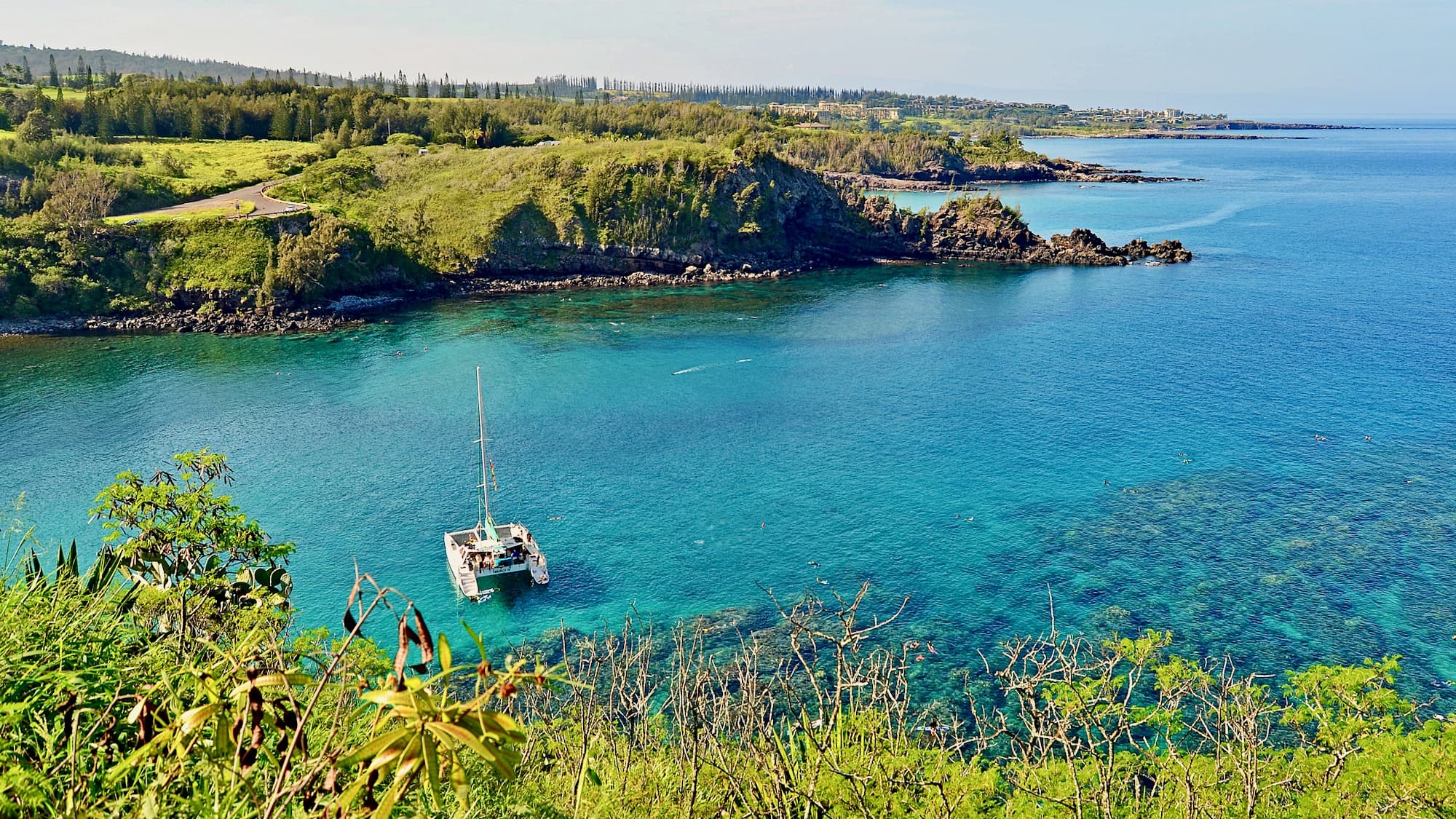If you’re headed to Maui, you’ll no doubt schedule your fair share of time at the beach. But don’t forget to arrange some time on the water as well. Maui’s western and southern shores are absolutely perfect for boating, with several islands offshore and many opportunities for wildlife sightings, especially whales in the winter. Scuba diving, sailing, kayaking, and fishing charters are also great ways to experience the ocean.
Regardless of your activity level and interests, there’s a way for everyone to experience Maui’s waters. Below, we break down the available water activities on Maui.
Table of contents
Table of Contents
- Snorkeling
- Surfing
- Bodyboarding
- Scuba diving
- Whale Watching/Sailing (tours)
- Kayaking/Paddling/SUP
- Fishing Charters
Related Guides: Looking for a comprehensive and honest overview of water activities on the other Hawaiian islands? We got you! Check out the following guides:
- Overview of water activities on Kauaʻi
- Overview of water activities on Oʻahu
Snorkeling
There are opportunities to snorkel everywhere in Maui, but most of its revered spots are located on the south and western shores. From La Perouse Bay, ‘Āhihi Kinau, and “Turtle Town” down south, to Black Rock, Kahekiki Beach and Honolua Bay out west – not to mention Molokini more than two miles offshore – Maui is loaded with snorkeling experiences that span all abilities and all levels of adventure.
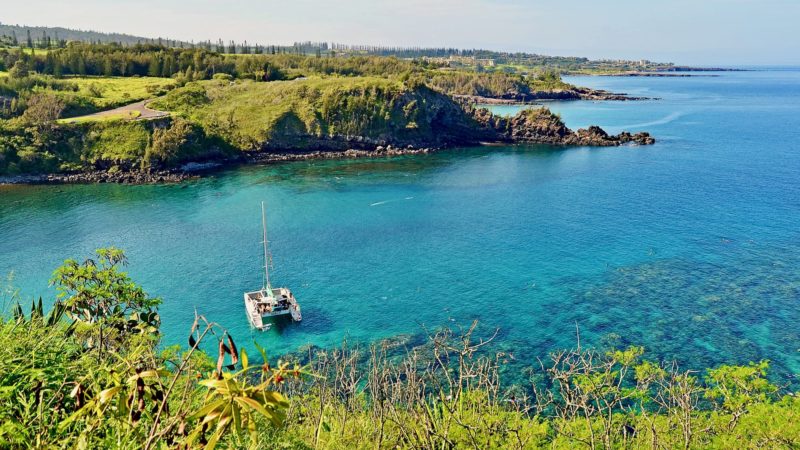
Snorkelers and a catamaran in Honolua Bay, one of the few sheltered bays to snorkel on Maui. Image credit: Edmund Garman, source.
Snorkel tours
There are many “from the beach” snorkel opportunities on Maui, and at its most basic, snorkeling can be as easy as renting or buy a mask and fins and walking out into the water. There are also snorkeling tours that leave from Lahaina and Maalaea Harbor that will take you to deeper sites offshore, such as Molokini Crater or Turtle Town.
Molokini Snorkeling Tour & Catamaran Sail
Sail a catamaran to Maui’s most incredible snorkeling destination: Molokini. Breakfast and lunch are included!
from:
$180
What is a suggested tour?Our suggested tours are hand-picked tours that receive consistent good reviews, give back to the community, and work hard to minimize their impact on the environment. Read more about these tours on our website.These snorkel boats range in what they offer. Some take place on big boats (100+ people) and offer lunch and other activities, like slides or platforms to jump from. Other tours are smaller and basic. You’ll have to shop around to find the best combination of price and amenities.
Either way, if you’re inexperienced, joining a tour is a great way to learn and snorkel safely, and regardless of ability, they provide a way to access deeper, offshore sites.
10 best snorkeling spots on Maui
To learn more, read our guide to snorkeling on Maui. There you can find a list of our 10 favorite snorkeling sites, along with a map, tips, and recommendations for beginners, families, etc..
Read more: See also our guides for favorite snorkeling spots on Oʻahu and on the Big Island.
Surfing
No matter where you’re staying on the island, you won’t be far from a surf break. Though it lacks the quantity of breaks that you find on O‘ahu, Maui does have a lot to offer surfers, including an internationally-known surf break of its own, Pe‘ahi – better known around the world as “Jaws.”
This massive break, found off the coast of Hai‘kū on Maui’s North Shore, produces some of the largest waves recorded in Hawai‘i, sometimes up to 50 or even 60 feet in height. Obviously, Jaws is for world-class experts only, but do check in with locals to see if it’s breaking while you’re on island. If so, you may want to make your way over and watch.
Surf spots
For beginner surfers, there are a couple friendly breaks on Maui’s west coast. Puamana Beach in Lāhainā produces easy-going waves for longboarding, and nearby Launiupoko has a mix of novice and intermediate terrain. In Kīhei, try Kīhei Cove. Those with more experience can check out the scene at Hoʻokipa (North Shore), cruise east to Hāmoa in Hana, or out west in Honolua Bay.
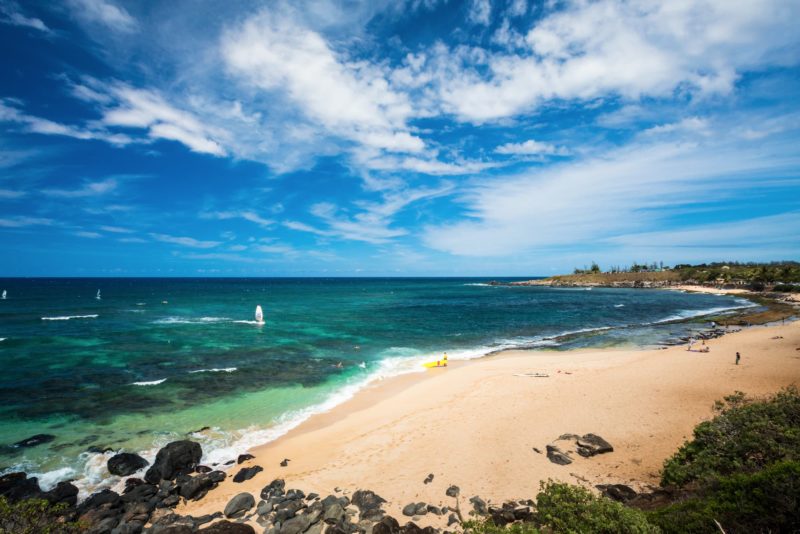
Located at Mile #9 on Hana Highway, Hoʻokipa is a beautiful white sand beach that boasts some of the best waves on the Maui coastline. Credit: Hawaii Tourism Authority (HTA) / Tor Johnson
Surf classes
If you’re interested in taking a lesson, or have questions about the swells or breaks, seek some expert advice. You can try well-known companies like Maui Surfer Girls (Lāhainā) or Maui Waveriders (Kīhei), but be sure to price hunt, as you may be able to find group deals or special offerings elsewhere with one of the many other surf schools on Maui.
Bodyboarding
If you’re not quite ready to stand up on a surfboard – or if you’ve been there done that – try another of Hawaiʻi’s favorite watersports, bodyboarding. In fact, going by the numbers, bodyboarding might be even more popular than surfing, considering it has a lower barrier to entry, is done close to shore, and is extremely popular with families and small children.
Bodyboarding can be done at just about any beach with a shorebreak, and for those just starting out, riding the whitewater is what it’s all about. Take a look as you travel around the island, and you’re sure to see people bodyboarding just about everywhere. Some beaches, like Kamaole III, or Fleming Beach Park, are known as bodyboarding beaches.
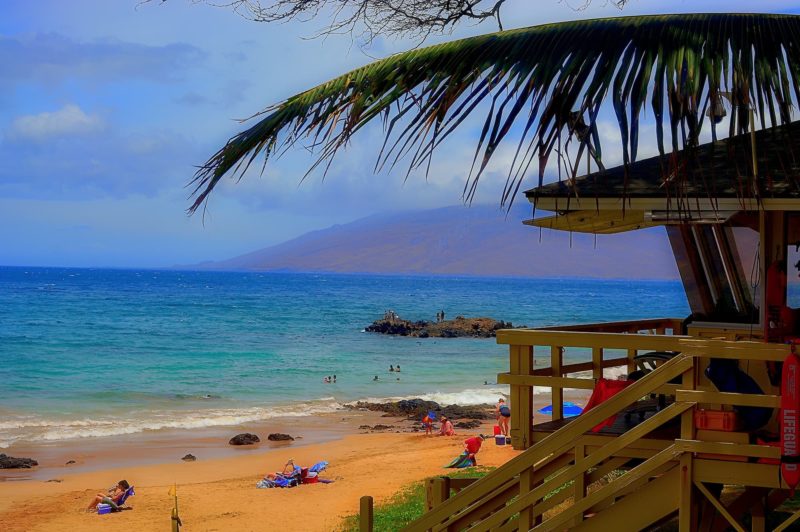
Kamaole III has one of the most regular South Maui shorebreaks for bodyboarding. Image credit: Kirt Edblom, source.
Keep in mind, while bodyboarding is accessible, it can also be very dangerous in strong wave conditions. Don’t underestimate the strength of shore breaks in Hawaiʻi. Always observe the ocean before getting in, and if you’re unsure, check with lifeguards before entering the water.
Read More: Check out our guide to Maui’s Beaches to discover other bodyboarding breaks.
Scuba Diving
Maui is a wonderful place to scuba dive thanks to its clear, calm, and warm water. Most tours leave out of the west and south shores in Lāhainā, Maalaea, or Kīhei area. There are many companies that offer both beginner and advanced dive trips, as well as personal instruction and lessons.
Popular dive sites in and around Maui include the backside of Molokini, Honolua Bay, Kahekili Beach Park, and many spots along the south shore in an area called “Turtle Town.”
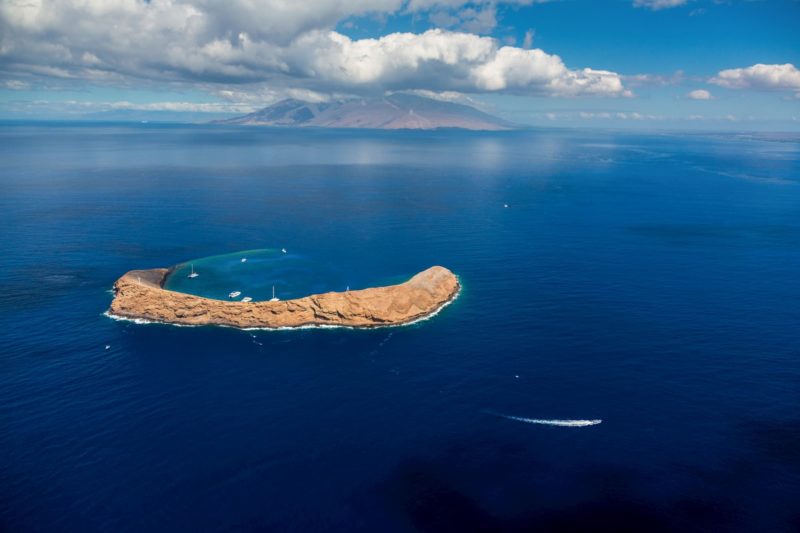
Molokini (with Kaho’olawe in the background) is one of the best places for snorkeling and scuba diving on Maui. Credit: Hawaii Tourism Authority (HTA) / Tor Johnson
Some companies, like Dive Maui, run trips to nearby Molokaʻi or Lānaʻi. Both of these islands have revered dive sites, like the Hammertime Channel on Molokaʻi, where hammerheads are often spotted, or the Lānaʻi Cathedrals, where you can explore underwater lava tubes.
Related: See also our guide for scuba diving on the Big Island.
Whale watching / Sailing (Tours)
We have grouped the sailing cruises and whale watching sections together because, at certain times of year, you can’t go on a sailing or boat tour without it being a whale watching tour.
Maui is considered by many the best Hawaiian island for whale watching because of the shallow ʻAuʻau Channel that runs alongside its western shores. This shallow channel brings the whales closer to the surface and increases your chances of spotting them breaching or hunting for krill or small fish.
Every year from November through April, more than 10,000 humpback whales make their way from Alaska to Hawaiʻi to give birth in its warm waters. The whales can be found throughout the state of Hawaiʻi, but they are most concentrated in the ʻAuʻau Channel off Maui’s west coast. The whales like the deep, protected waters here that allow them to raise their young in peace.
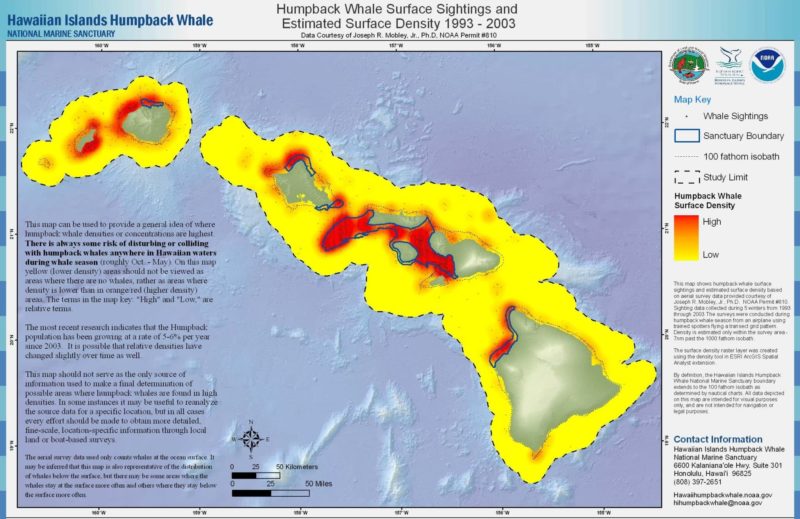
This map shows where you can best see whales on Hawaii. The red zones are the best spots to see whales, and as you can see, the western and southern shore of Maui are right in the center of the whale-action!
Believe us, during this time of year, everything you do along the western and southern shores of Maui could be considered a whale watch. At all times of the day you will see them breaching, tail slapping, and breathing at the surface, whether you’re eating at a waterfront restaurant, walking a beach path, or boating out in the channel.
Maui Whale Watching Tours
Of course, the latter is where you get an up close and personal look. There are many types of whale watching tours available on Maui, from big boats like the Pacific Whale Foundation, to small-group experiences on pontoon boats such as the adventure offered by Captain Steve’s Rafting, to mid-sized sailing ships offering classic whale watching experiences such as those by Sail Maui:
Saltwater Sail With the Whales on Maui
Maui is the place to see humpback whales! Set sail in the Hawaiian tradewinds and join the Captain and Crew in keeping a look out for humpback whales
from:
$85
What is a suggested tour?Our suggested tours are hand-picked tours that receive consistent good reviews, give back to the community, and work hard to minimize their impact on the environment. Read more about these tours on our website.If you find yourself on Maui outside of whale season, fret not.
The boating and sailing tours are still spectacular, providing views of Moloka‘i, Lāna‘i, Kaho‘olawe, and the Molokini Crater – not to mention the views from the boat looking back on Haleakakā, rising 10,000 feet from sea to summit. Most of the same companies who offer whale watching in the winter pivot to scenic tours during the summer, often combined with snorkeling. In both seasons, the majority of tours leave from Lāhainā or Maʻalaea harbors.
Whale Watching on Oʻahu and the Big Island
See our guides for whale watching on Oʻahu and whale watching on the Big Island for the best whale watching tours and places to see the whales from the coast on each of those islands.
Kayaking/Paddling/SUP
There are many non-motorized ways to get out on the water that don’t include riding big surf. Kayaking and stand-up paddleboarding are popular at many beaches and scenic coastlines, and paddling Hawaiian outrigger canoes is both a historic and modern day favorite amongst locals.
Kayaking
Kayaking can be as simple or as extensive as you want. Many people simply rent a kayak from the nearest outfitter and launch off the closest beach. From there, they cruise around and enjoy the exercise and views back toward land. Those looking for more adventure launch in areas like La Perouse Bay or ‘Āhihi Kinau, where they can explore the volcanic coastline.
See our guide to kayaking on Maui for the best locations, tours, and rentals.
SUP
The same goes for stand-up paddleboarding. You can rent one and take it out on a calm day or in a protected bay; or you can head out to a surf break and use it as a longboard.
Paddling (outrigger canoes)
Paddling Hawaiian outrigger canoes is a more unique experience, as it’s not regularly found in other places. In ancient times, Hawaiian’s used outrigger canoes as their main transportation and fishing vessels, and today, paddling clubs can be found all across the state, in almost every region of every island. A combination of community and exercise, paddling clubs range in competitiveness. Some are there for fun; others train to compete in races, of which there are many throughout the year.
Hawaiian Outrigger Canoe Cultural and Turtle Tour
Enjoy the pristine waters off Wailea point and abundant sea life (including turtles!) while you experience a traditional Hawaiian Outrigger Canoe Tour and learn the culture, art, and sport of canoe paddling.
from:
$89
What is a suggested tour?Our suggested tours are hand-picked tours that receive consistent good reviews, give back to the community, and work hard to minimize their impact on the environment. Read more about these tours on our website.Rentals
Regardless of your interest in either of the three sports, we recommend going beyond the basics. For example, Hawaiian Paddle Sports in Kīhei combines history, culture, and adventure in its tour offerings. Whether you want to kayak, SUP, or paddle, their tours take the time to explain the cultural significance of the areas you visit and pay homage to Maui with a number of give-back, community programs.
Fishing and fishing charters
Considering that Hawai‘i is a state surrounded by water, it should come as no surprise that fishing is one of the most popular activities amongst locals. Tuna, wahoo, marlin, mahi mahi, shark, snapper, mackerel, and many other species can be caught off Maui’s shores.
If you just want to buy a pole and fish from the shore, you can simply do so – no permit or license is required, and fishermen are literally everywhere, so it shouldn’t be hard to strike up a conversation and ask for some advice.
Fishing charters
If you’re looking to fish offshore from a boat, there are two main types of trips on Maui: sport fishing and bottom fishing. The former is where you go after bigger fish, like tuna, out on the open ocean. Bottom fishing tends to be more mellow and family-friendly, with a higher likelihood of catching smaller fish. Some companies combine bottom fishing with the chance to snorkel as well.
Something important to keep in mind and ask when booking a fishing charter: By Hawaii law, the fish you catch is not your fish. Anything caught while on a fishing trip remains the property of the charter company, and it’s up to them whether or not they distribute it to guests on board (yes, even if you caught the fish yourself). This is a major point of frustration for many guests, so be sure to ask when booking so you are aware of such a policy up front. Many boats will only allow guests to keep part of the fish, with the rest being kept by the boat or sold to market. Some have very specific policies regarding the weight of the fish, so you’ll have to inquire individually with each company.
Read More: If you want to know more about fishing on Maui, Fish Maui is a good resource, with explanations of the local fish, local charter policies, and booking services.
Water activities overview for Oʻahu, Kauaʻi and the Big Island
We have also written water activity overview articles for the other main Hawaiian islands full with local tips and recommended beaches/locations and tour operators. Read more about those at:
- Water activities on Oʻahu
- Water activities on Kauaʻi
- Water activities on the Big Island (no overview yet, but see our main guides on snorkeling, beaches, surfing, diving, the Manta Ray Dive, SUPping, and Whale Watching).
